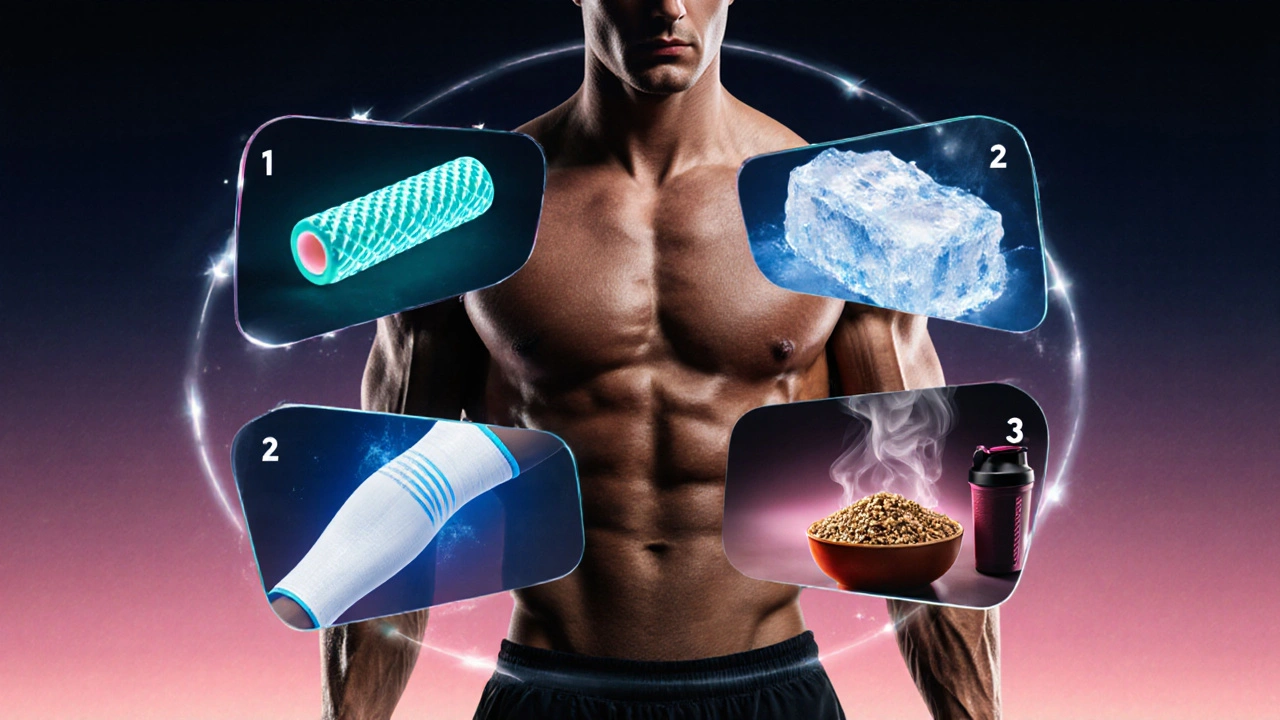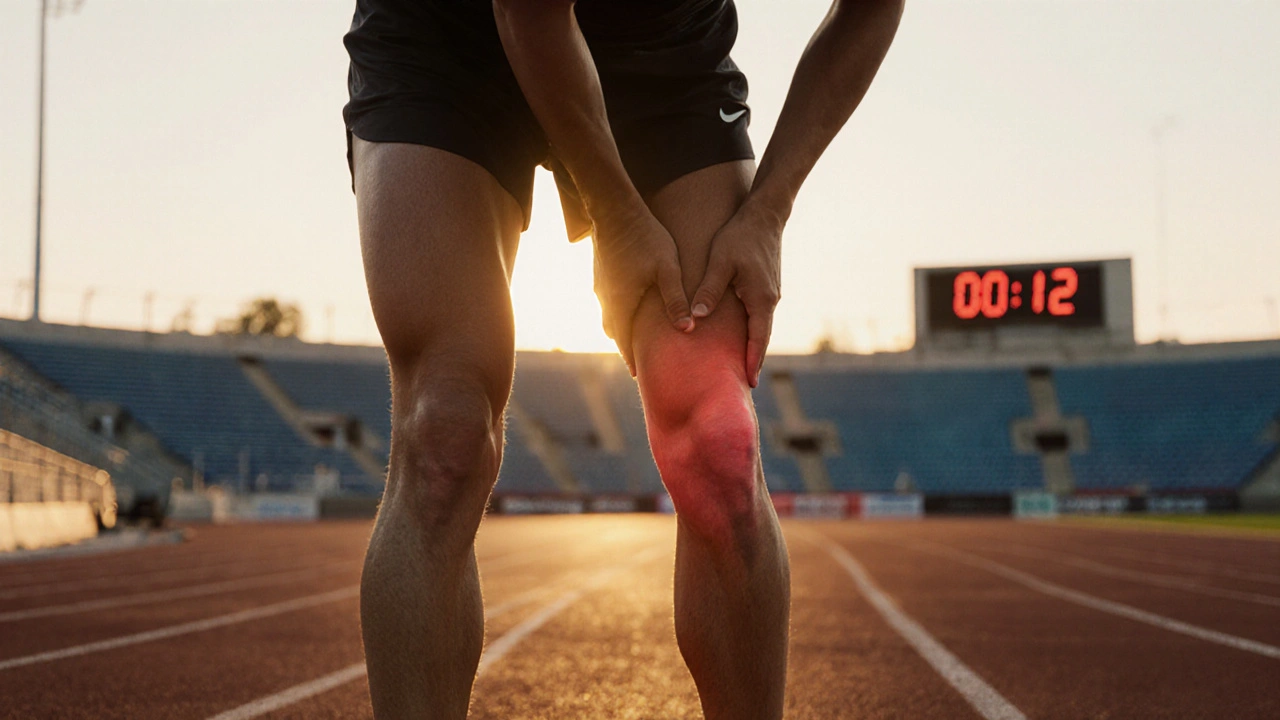Muscle Ache Impact Calculator
Assess Your Post-Workout Aches
Rate your muscle soreness and assess its impact on your performance to receive tailored recovery advice.
Ever felt a lingering ache after a hard training session and wondered why your sprint feels slower or your lift feels weaker? That nagging muscle aches isn’t just a nuisance-it can shave seconds off a 100‑m dash or cost a few kilograms in a deadlift. This guide breaks down exactly how those pains creep into your stats and, more importantly, what you can do today to stay on top of your game.
TL;DR
- Muscle aches, especially delayed onset muscle soreness (DOMS), reduce strength, power and coordination for 24‑72hours.
- Key drivers are micro‑tears, inflammation and altered nerve signaling.
- Active recovery (light cardio, foam rolling, stretching) restores blood flow and speeds up repair.
- Nutrition (protein+carbs), quality sleep (7‑9h) and hydration are the fastest performance protectors.
- Use a simple checklist after each session to gauge pain, decide on recovery actions, and prevent performance drop.
What Exactly Are Muscle Aches?
Muscle aches are painful sensations in skeletal muscle that arise after unaccustomed or high‑intensity activity. They range from a mild, dull throb to a sharp stabbing feeling and typically peak 24-48hours post‑exercise.
When the term delayed onset muscle soreness (DOMS) pops up, think of the same phenomenon but specifically linked to eccentric contractions-those “lengthening under load” movements like downhill running or lowering a dumbbell.
Why Muscle Aches Slow You Down
Performance isn’t just about skill; it’s a balance of force production, neural firing, and metabolic efficiency. Muscle aches disrupt three core pillars:
- Force output: Micro‑tears in myofibrils reduce the number of contractile units that can fire simultaneously, trimming peak power by up to 15%.
- Neural coordination: Pain signals alter motor unit recruitment patterns, making movements feel clumsier and increasing reaction time.
- Metabolic cost: Inflammation raises the body’s basal temperature and oxygen demand, meaning you burn more energy just to maintain the same pace.
Research from the Australian Institute of Sport (2023) showed that elite sprinters with moderate DOMS ran 0.12seconds slower over 200m compared to a pain‑free state.
Root Causes: What Triggers the Aches?
Understanding the biology helps you target the right fix.
- Micro‑tears: Tiny disruptions in muscle fibers caused by eccentric loading.
- Inflammation: Release of cytokines and prostaglandins that sensitize nerve endings.
- Lactate accumulation: Though often blamed, lactate clears within an hour; it’s the secondary metabolic by‑products that linger.
- Depleted glycogen: Low energy stores impair repair processes, extending soreness.
Assessing the Severity
Not all aches need the same response. Use a quick three‑step check after each workout:
- Rate pain on a 0‑10 visual analog scale.
- Test functional impact: can you squat to parallel without wobbling?
- Check swelling or reduced range of motion.
If the score is ≤3 and movement is near normal, active recovery is sufficient. Scores ≥7 or restricted motion may warrant additional modalities (ice, compression, professional assessment).

Recovery Toolbox: What Works Best?
Below is a side‑by‑side look at the most common recovery methods. Pick the combo that fits your schedule and sport.
| Method | Primary Mechanism | Time to Benefit | Best For |
|---|---|---|---|
| Ice therapy | Vasoconstriction reduces swelling | 15‑30min post‑session | Acute inflammation, acute injuries |
| Heat therapy | Increases blood flow, relaxes tissue | 20‑40min before activity | Stiffness, chronic tightness |
| Foam rolling | Myofascial release, improves perfusion | 5‑10min per muscle group | DOMS, limited ROM |
| Compression garments | Reduces fluid buildup, supports proprioception | During and up to 24h post‑exercise | Endurance events, post‑marathon recovery |
| Active recovery (light cardio) | Accelerates lactate clearance, promotes circulation | 10‑20min low intensity | All sports, especially after HIIT |
Most elite programs layer at least two techniques-ice for immediate swelling plus foam rolling for tissue quality.
Nutrition & Sleep: The Hidden Performance Boosters
Recovery is 70% nutrition and sleep, 30% external modalities.
- Protein intake: Aim for 1.6-2.2g perkg body weight within 2hours post‑workout. Whey or plant blends with leucine≥2.5g maximize MPS (muscle protein synthesis).
- Carbohydrate replenishment: 1.0‑1.2g perkg restores glycogen, reduces cortisol spikes.
- Omega‑3 fatty acids: Anti‑inflammatory EPA/DHA (2g daily) blunt cytokine response.
- Sleep hygiene: 7‑9hours of uninterrupted sleep boosts growth hormone, essential for tissue repair.
Prevention: Train Smarter, Not Just Harder
Stopping aches before they start is cheaper than treating them.
- Progressive overload: Increase volume or intensity by <10% per week to let connective tissue adapt.
- Dynamic warm‑up: 5‑10minutes of movement‑specific drills (leg swings, high‑knee skips) raise muscle temperature and prime neural pathways.
- Hydration balance: Dehydration amplifies perceived pain; aim for 35ml perkg body weight daily, more in hot climates.
- Periodization: Cycle hard weeks with recovery weeks to avoid chronic over‑training.
Quick Post‑Workout Checklist
- Rate pain 0‑10.
- Perform a functional test (e.g., single‑leg squat).
- Choose recovery combo: ice+foam roll if pain≥4; active recovery only if ≤3.
- Consume 20‑30g protein & 40‑60g carbs within 30minutes.
- Log sleep hours; aim for ≥7h tonight.
When to Seek Professional Help
If pain:
- Persists beyond 5days.
- Is sharp, localized, and worsens with movement.
- Accompanied by swelling, bruising, or loss of strength.
Schedule a physiotherapist or sports medicine doctor to rule out tears, tendinopathy, or stress fractures.
Frequently Asked Questions
How long does DOMS usually last?
Typical DOMS peaks 24‑48hours after the workout and fades within 72hours. The exact timeline depends on intensity, eccentric load, and individual recovery capacity.
Is stretching before exercise helpful for preventing muscle aches?
Static stretching before activity can actually reduce power output. A dynamic warm‑up is more effective for preparing muscles and reducing later soreness.
Can NSAIDs speed up recovery?
NSAIDs may lower pain temporarily, but they can also blunt the inflammatory signaling needed for muscle adaptation, potentially slowing long‑term gains.
What’s the best time to use foam rolling?
Foam roll both after workouts (to reduce DOMS) and on off‑days (to improve tissue pliability). Spend 30‑60 seconds per tight spot.
Does cold water immersion help?
Cold immersion (10‑15°C for 10‑15minutes) cuts swelling and perceived soreness, but some studies show it may slightly reduce strength gains if used after every session. Use it selectively for high‑intensity events.


Paula Hines
October 1, 2025 AT 21:32When you push your muscles beyond their accustomed load the fibers experience tiny ruptures that signal the brain to protect the tissue. This protective signal manifests as a dull ache that persists long after the workout is over. The ache is not merely a sensation but a reminder that the body is in a state of repair. During repair the muscle fibers rebuild stronger, a process known as supercompensation. If you ignore the ache and train again you risk compounding micro‑tears and diminishing returns. The nervous system also responds by altering motor unit recruitment to avoid pain. That alteration reduces the efficiency of force production and can shave milliseconds from a sprint. In endurance events the extra metabolic cost of inflammation can increase oxygen consumption. Researchers have measured a 5 to 10 percent drop in power output when athletes report moderate soreness. The cumulative effect of these drops over a season can be the difference between a podium and a mid‑pack finish. Therefore a strategic approach to recovery is essential for performance longevity. Simple actions such as active recovery increase blood flow and deliver nutrients to the damaged fibers. Ice therapy can limit swelling by causing vasoconstriction in the acute phase. Foam rolling assists in myofascial release and improves tissue pliability. Adequate protein and carbohydrate intake within the post‑exercise window maximizes muscle protein synthesis. Finally, consistent sleep of seven to nine hours supports hormonal pathways that drive tissue repair. Ignoring any of these pillars will let the ache linger and your performance suffer.
John Babko
October 3, 2025 AT 01:18Great article, folks, you’ve nailed the science, and the practical tips are spot‑on, I love how you broke down the mechanisms, and the recovery toolbox is solid, keep it up!!
Stacy McAlpine
October 4, 2025 AT 05:05That thing about protein after a workout is key, just grab a shake or some chicken and rice, it’ll help the muscles heal fast.
Roger Perez
October 5, 2025 AT 08:52Recovery is like the calm after a storm 🌧️➡️☀️, you let the body rebuild, you stay positive, you’ll bounce back stronger 😊.
michael santoso
October 6, 2025 AT 12:38The author’s reductionist view ignores the complex interplay of cytokines, hormonal cascades, and neural plasticity, thereby presenting an oversimplified remedy that belies current literature.
M2lifestyle Prem nagar
October 7, 2025 AT 16:25Rest and nutrition are non‑negotiable.
Karen Ballard
October 8, 2025 AT 20:12Exactly, the punctuation is on point 👍, but don’t forget to hydrate!
Gina Lola
October 9, 2025 AT 23:58From a periodization perspective, the DOMS curve aligns with the eccentric loading phase, thus adjusting the taper can mitigate performance dips.
Leah Hawthorne
October 11, 2025 AT 03:45You’ve captured the concept well, just watch the sentence structure for clarity.
Kevin Huston
October 12, 2025 AT 07:32Man, those aches are like tiny gremlins crawling up your muscles, sabotaging every rep, but you can kick them out with some ice, a blast of compression, and a solid dose of protein, so don’t let that pain police your progress.
Amanda Hamlet
October 13, 2025 AT 11:18i think u should just ignore the pain it’s just in your head lol
Nolan Jones
October 14, 2025 AT 15:05For anyone dealing with lingering soreness, a 10‑minute light jog or cycling session can boost circulation, and adding dynamic stretches post‑cardio further speeds up recovery.
Jada Singleton
October 15, 2025 AT 18:52Honestly, most athletes treat aches like an excuse, and that mindset shows a lack of discipline.
Emily Rossiter
October 16, 2025 AT 22:38Remember to listen to your body, schedule rest days, and keep your nutrition on point for sustainable progress.
Renee van Baar
October 18, 2025 AT 02:25While short, the key takeaway is simple: incorporate active recovery, proper nutrition, and adequate sleep to minimize performance loss caused by muscle soreness.
Mithun Paul
October 19, 2025 AT 06:12The foregoing discourse, whilst informative, neglects to address the quantitative metrics requisite for evaluating recovery efficacy, thereby rendering the recommendations insufficiently rigorous.
Sandy Martin
October 20, 2025 AT 09:58I totally get how frustrating DOMS can be, and taking a gentle walk or using a foam roller can really help the muscles feel better.
Steve Smilie
October 21, 2025 AT 13:45One must transcend the pedestrian notion of merely icing and embrace a holistic paradigm of recovery that fuses biochemical insight with avant‑garde therapeutic modalities.
Josie McManus
October 22, 2025 AT 17:32Don’t let the ache dictate your schedule; plan your training cycles with built‑in recovery windows, monitor your soreness levels, and adjust intensity accordingly to stay on track.